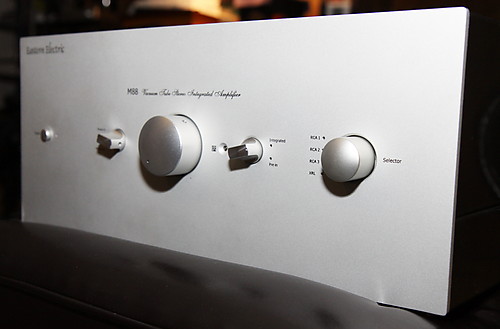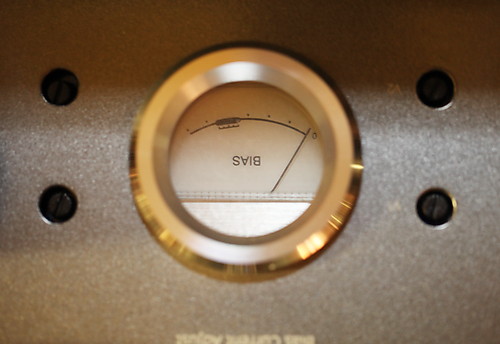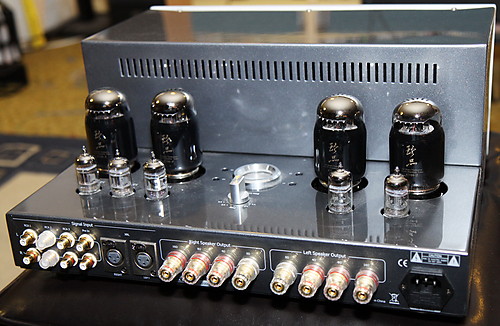Eastern Electric M88
Photos: Erik Putens
The last two pairs of speakers that I reviewed are tube-friendly designs. So tube-friendly, in fact, that their designers would go so far as to suggest that it be preferable to drive their speakers with just one, solitary tube per speaker – the approach known to you and me as “single-ended.” I may or may not agree with this suggestion. My experience listening to both the Zu Soul “Superfly” and the Sonist Concerto 2 was that they do indeed prefer tubes but to my ears, I needed a bit more oomph than that provided by a single-ended amp. Or at least any single-ended amp I had at my disposal.
What I did find to be a deal breaker, especially for the Zu’s was to have proper impedance matching between the speaker and the amp. The Zu’s are a 16 ohm speaker which, somewhat to my surprise, is a difficult specification to find in an amp – especially modern-day designs. While reviewing the Zu’s, I discovered that they sounded best using vintage amps (Dynaco ST-70, Fisher 20A) that came with 16 ohm transformer taps. So, I got to thinking that there had to be a good, modern-day amp on the market that is tubed (preferably push-pull) and has both 8 and 16 ohm taps, and is reasonably priced. If you are reading this, you probably know that there is no shortage of tube amps on the audiophile market. You also would not be surprised to know that a whole lot of them are push-pull. I bet you wouldn’t gasp to discover that there are even some that are “reasonably priced” (though that is a subjective term). As my search continued, the criterion (and perhaps the most crucial one) was finding an amp with both 8 and 16 ohm taps. Virtually all amplifiers have 8 ohm taps as they are the most conventional. Of the amps that have two taps, the second is always 4 ohms. Unlike the first generation tube amps that seemed to all offer 4, 8, and 16 ohm taps, I found there are very, very few modern amps that do the same.
In pretty short order, my search began to feel like a challenge to find a tube amp that met my requirements. At some point, I came across the Eastern Electric M88 and saw that it offers all three impedance values. I felt like Clark Griswold finally finding his family after stumbling through the desert. “They do exist! I knew it,” I thought to myself, practically sobbing on the keyboard that sat in front of me. Furthermore, I have heard numerous good things about Eastern Electric’s MiniMax phono stage, not to mention the overwhelmingly positive things I read on the Internet regarding the M88, which made my request to review the amp a no-brainer.
The versatility of the amp is impressive. The M88 is a 40-watt integrated amp that offers three RCA and one set of balanced inputs and the above stated 4, 8 and 16 ohm transformer taps. The user has the option to run the amp as an integrated or to bypass the preamp section and use it strictly as an amplifier. Neat! The M88 is based around the KT88 output tube, which is biased via the convenient, built-in bias meter and bias pots. Each KT88 has its own bias pot. Short of a self-biasing design, biasing tubes does not get any easier than this. I actually enjoyed doing it.
The large, front panel of the M88 has the basic functions of an integrated amp, plus one. With the flip of the wrist, the user can switch the phase. Other than that, you have a large volume knob and the source selector knob, a knob to specify whether you are running the M88 as an integrated or a standalone amp, and the power button. It’s a rather simple, uncluttered, necessarily audiophile design. The M88 comes with a remote, which appears to be aluminum. Whatever it is, the overbuilt half-brick could easily shatter a window if it were thrown at one. Via the remote, you can adjust for volume and switch inputs.

Upon getting the M88 from the man in brown, I unpacked it and was immediately struck at the size of the thing. The M88 is a lot bigger than I had anticipated in both height and depth. I think I was expecting something smaller based on the company’s smallish “Mini” line. Whatever the case, the M88 is a large, substantial piece of equipment. The M88 is an attractive, well-built item. My only complaint is that I wish the tubes were up front. The tubes sit behind the large front panel and unless you look from above or behind the amp, you don’t see them. I like tube amps that show off the tubes. From the front, the M88 looks like a large solid state amp.
Setting the amp up is about as straight-forward as it can be. Upon powering the amp up, it goes through a short, 30-second warm-up phase. During this time, the small LED on the volume knob blinks. After about 30 seconds, you hear a small click and the LED stops blinking, indicating that the amp is ready to play. The instructions say to bias the tubes once at this point and then again in an hour. After that, short of swapping out the tubes, the user should not have to bias the tubes any more – not that I would mind doing so. Like most all other audio components, I found the M88 to sound best after being on for about an hour.

Since I had my system set up using my standard Bottlehead Foreplay linestage, I decided to try out the M88 as a standalone amp first. My first impression was that it sounded rather good. I sifted through a number of jazz recordings and listened to the M88 as an amp driving the Sonist Concerto 2’s. After a few days with this configuration I decided to see how the M88 sounded as an integrated. No contest . It hands down sounded better as an integrated, using its own preamp section. I tried this comparison with each set of speakers I used during the review period as well and the M88 always sounded better as an integrated. I only tried this using my Bottlehead Foreplay so perhaps it wasn’t a good match or the M88’s preamp section was simply better. Whatever the case, in my system, the M88 sounded best as an integrated so I focused on it as such for the majority of the review.
I auditioned the M88 with three different sets of speakers: the above stated Zu’s and Sonists, as well as my tried and true Acoustic Energy Aegis 3’s. Of the three, the AE’s paired the least favorable with the M88, and that didn’t necessarily surprise me. Though the Aegis 3 is a somewhat versatile and easy to drive (92.5 dB/W/m) speaker, I have found that it prefers an average amount (100 watts, give or take) of solid state power to spring to life and to show what it’s capable of. They didn’t sound at all bad when attached to the M88, but knowing what the speakers can sound like, I was left a bit disappointed. The AE’s highlighted the stereotypical tube amp traits. The midrange was lush but the frequency extremes were a tad rolled off and the speakers usual impressive spatial qualities and vivid control were diminished. Old jazz recordings and other recordings done in the same manner sounded agreeable in that the midrange blossomed and sounded great. On the other hand, listening to the current crop of dubstep superheroes like Skrillex and Deadmau5 didn’t work at all. The combo couldn’t quite keep up with the frequency extremes and the rate at which the ADD music switches gears. If I was at an audio show and walked into a room and heard a system that sounded like what I heard with the M88/AE combo playing acoustic music, I wouldn’t think it sounded bad. I’m coming at this from the other side though where I know what the speaker already sounds like – or can sound like.
Next up, I tried the Zu Soul “Superfly’s” with the M88. I’ll admit to feeling some satisfaction simply connecting the speaker cables to the 16 ohm tap if for no other reason than the 16 ohm tap was even there. I listened for hours on end to the M88/Soul combo and decided that the two sounded quite good together but the Zu’s didn’t shine to their full capacity when being driven by the M88. Though the M88 is a tube amplifier (which is old technology by most folk’s standards), it sounds new in that it doesn’t necessarily possess all of the clichéd tube personality traits. The M88/Soul combo had a presentation that was very intact and tight – perhaps to a fault. Bass was very taught and present and controlled. What lacked was air and delicate shimmer. There really wasn’t anything romantic or seductive about the presentation but rather it was very analytical. I realize that this may be a quality that some seek but I will also say that if it is not, I have heard the Zu’s be seductive and romantic and lush when being driven by old tube amps as the speakers seem to manipulate the old amps questionable qualities in their favor. My experience with the Zu’s have also told me that they are very sonically finicky speakers, and that finickiness is based on the amp driving them.

Lastly was the M88/Concerto 3 combo. This was the set-up that I think had both the speaker and the amplifier in as close to an ideal setting as I could provide. Matter of fact, when being driven by the M88 (as an integrated) was the best I had heard the Sonists in my listening room. What was lacking in the M88/Soul combo was more than made up for here. The M88 provided the C3’s to shimmer and shine with plenty of air and space – throwing a big, and most notably, deep soundstage. The frequency range of the C3’s was balanced but my only complaint being the bass was a bit rolled off and slightly undefined. The C3’s aren’t a big bass speaker in the first place, though the M88 didn’t do anything to correct that. My only other complaint of the M88 here was that it didn’t provide as much texture as I would have hoped, especially given the fact that it is a tube amp. The 40 watts provided by the M88 was just right for the 95 dB C3. The speakers were able to play loud – as loud as I wanted without ever hearing a trace of clipping or strain. The M88 also proved to be a worthy amp in terms of providing dynamic drama while maintain the flow and timing of the music. The Sonist’s are designed to be primarily used with SET’s but if you’re like me and want more horsepower than most SET’s can provide, and you happen to own a pair of C3’s, I strongly recommend checking out the M88. I don’t think you’ll be disappointed.
Along with the stock tubes, the M88 came with some fancy, higher-end tubes, which I did use and as you may have suspected, sounded better than the stock tubes. The music became more delicate and more present and pronounced with a smidge more texture. The tubes in question are a quartet of Fi KT88’s and two Psvanne 12AU7’s.
So, three sets of speakers and three separate outcomes – surprise, surprise. Though I obviously thought the M88 sounded better with some speakers than with others, it never sounded bad with any of them. Had my first experience listening to the Acoustic Energy Aegis 3’s been through the M88, I would not have been at all disappointed. But I have had these speakers for years and driven them with a bunch of different amps, so I know these speakers characteristics better than most any speakers and know their capabilities when matched with the right amp.
Like any amplifier – or really any audio component – its merit really lies in whether it adds to or subtracts from the total synergy of the system in which it is placed. The M88 is no different. I think that at $1800, it’s safe to consider the M88 an entry-level audiophile component. Given its sonic attributes, build quality, and its incredible versatility and convenience (integrated or amp, bias meter), I think the M88 is an easy recommendation. That said, in order to know that it’s a marriage that’s going to last, you should try it out with your own speakers first.




What a nicely written piece, Thad. Hope to see more of you. Thanks.